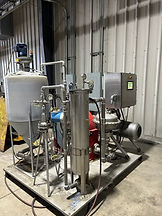

Erosion Resistant Screen Technology
Delta Screens collaborated with Chevron in their development of a coating to increase sand screen erosion resistance.
Scroll down to Learn More, or see SPE Paper SPE-210128-MS
Summary of Program and Results
-
A design optimized coated sand screen was developed that increases the erosion resistance of conventional sand screens.
-
Computational fluid dynamics and laboratory testing were conduced to determine the design optimization.
-
The program required designing a test fixture and flow loop to test the mesh filtraiton media
-
A coating was developed with rigorous testing at Delta Screens on mesh samples.
-
The screen has now been deployed and adopted with success in Gulf of Mexico and Angola.
-
The increased erosion resistance will improve completion life and recovery, critical in deepwater and other high reentry cost wells.
Business Need
-
Chevron worked with Delta Screens to develop a ‘design optimized coated sand screen’
-
Target applications were where cost effective increased screen life would improve recovery/well economics - deepwater, high rate wells with fines, and high re-entry cost wells
-
Computational fluid dynamics modeling and rigorous laboratory testing of mesh coatings and screen elements optimized the design
-
Installations in Gulf of Mexico and Angola have demonstrated improved erosion resistance

The test set-up was designed to efficiently test various coatings, working fluids, and flow rates for different durations.

The set-up was designed to efficiently test various coatings, working fluids, and flow rates for different durations. Item 7 is the test screen mesh disc.
Filtration Media Testing
-
Flow rates and sand content replicated well conditions
-
Fluid modeling iterated with testing of multiple coatings
-
Numerous other areas of screen design affecting erosion were optimized as part of the process
-
Acid testing was also performed to confirm the screen was suitable for stimulation completions

Uncoated Filter Media
Failure Point
1.57 hours at 15 GPM
Aperture at 25 Microns
This represents a loss of sand control

Coated Filter Media
Failure Point
7 hours at 15 GPM
Aperture at 25 Microns
This represents a loss of sand control
-
The 25 micron dimension change is based on typical acceptance values for the mesh of +25 / -25 or for some operators at +25 / - 50, micron.
-
Coating eroded uniformly, acting as a homogeneous layer with the substrate.
-
Coating was found to not affect welds, burst/collapse, but section lengths were shorter.
Failure Point

Time to failure testing demonstrated the design objective of double screen life for the filtration media had been achieved, and more.
Results
-
Coatings outperformed expectations
-
10 Different coatings were erosion flow loop tested on mesh samples
-
An initial target was set to double the erosion life from uncoated screens
-
Several functional, fabrication, manufacturing and quality control requirements were addressed
-
Example requirements included burst/collapse, pre-conditioning host wire before coating, coating uniformity, coating thickness tolerance, inner/outer layers
